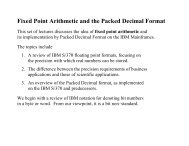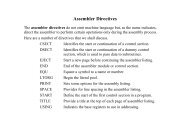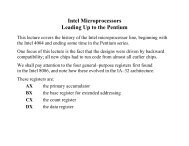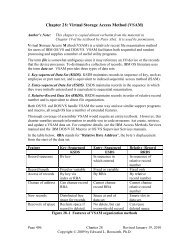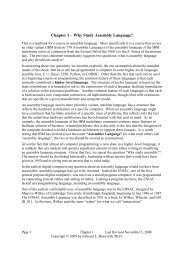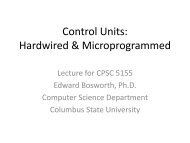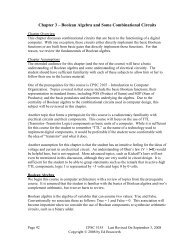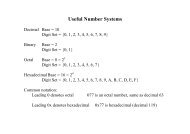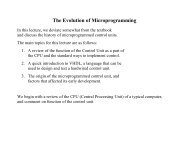Adobe PDF - Edwardbosworth.com
Adobe PDF - Edwardbosworth.com
Adobe PDF - Edwardbosworth.com
You also want an ePaper? Increase the reach of your titles
YUMPU automatically turns print PDFs into web optimized ePapers that Google loves.
Chapter 15 Boz–7 Implementation of the CPU<br />
The description above suggests the use of a micro–subroutine, which would be the<br />
microprogramming equivalent of a subroutine in either assembly language or a higher level<br />
language. This option imposes a significant control overhead in the microprogrammed<br />
control unit, one that we elect not to take.<br />
The “where to return issue” is easily handled by noting that the action next after executing<br />
any assembly language instruction is the fetching of the next one to execute. For reasons<br />
that will soon be explained, we place the first microoperation of the <strong>com</strong>mon fetch sequence<br />
at address 0x20 in the micromemory; each execution phase ends with “go to 0x20”.<br />
The structure of the dispatch operation is best considered by examination of the control<br />
signals for the <strong>com</strong>mon fetch sequence.<br />
F, T0: PC B1, tra1, B3 MAR, READ. // MAR (PC)<br />
F, T1: PC B1, 1 B2, add, B3 PC. // PC (PC) + 1<br />
F, T2: MBR B2, tra2, B3 IR. // IR (MBR)<br />
F, T3: Do something specific to the opcode in the IR.<br />
In the hardwired control unit, the major and minor state registers would play a large part in<br />
generation of the control signals for (F, T3) and the major state register would handle the<br />
operation corresponding to “dispatch”, that is selection of what to do next. Proper handling<br />
of the dispatch in the microprogrammed control unit requires an explicit micro–opcode and<br />
a slight resequencing of the <strong>com</strong>mon fetch control signals. Here is the revised sequence.<br />
F, T0: PC B1, tra1, B3 MAR, READ. // MAR (PC)<br />
F, T1: PC B1, 1 B2, add, B3 PC. // PC (PC) + 1<br />
F, T2: MBR B2, tra2, B3 IR. // IR (MBR)<br />
Dispatch based on the assembly language opcode<br />
F, T3: Do something specific to the opcode in the IR.<br />
The next issue for our consideration in the design of the structure of the microprogram is a<br />
decision on how to select the address of the micro–instruction to be executed next after the<br />
current micro–instruction. In order to clarify the choices, let’s examine the microprogram<br />
sequence for a specific assembly language instruction and see what we conclude.<br />
The assembly language instructions that most clearly illustrate the issue at hand are the<br />
register–to–register instructions. We choose the logical AND instruction and arbitrarily<br />
assume that its microprogram segment begins at address 0x80 (a new design, to be<br />
developed soon, will change this) and see what we have. Were we to base our control<br />
sequence on the model of assembly language programming, we would write it as follows.<br />
0x20 PC B1, tra1, B3 MAR, READ. // MAR (PC)<br />
0x21 PC B1, 1 B2, add, B3 PC. // PC (PC) + 1<br />
0x22 MBR B2, tra2, B3 IR. // IR (MBR)<br />
0x23 Dispatch based on the assembly language opcode<br />
0x80 R B1, R B2, and, B3 R.<br />
0x81 Go to 0x20.<br />
Page 540 CPSC 5155 Last Revised July 9, 2011<br />
Copyright © 2011 by Edward L. Bosworth, Ph.D. All rights reserved.



